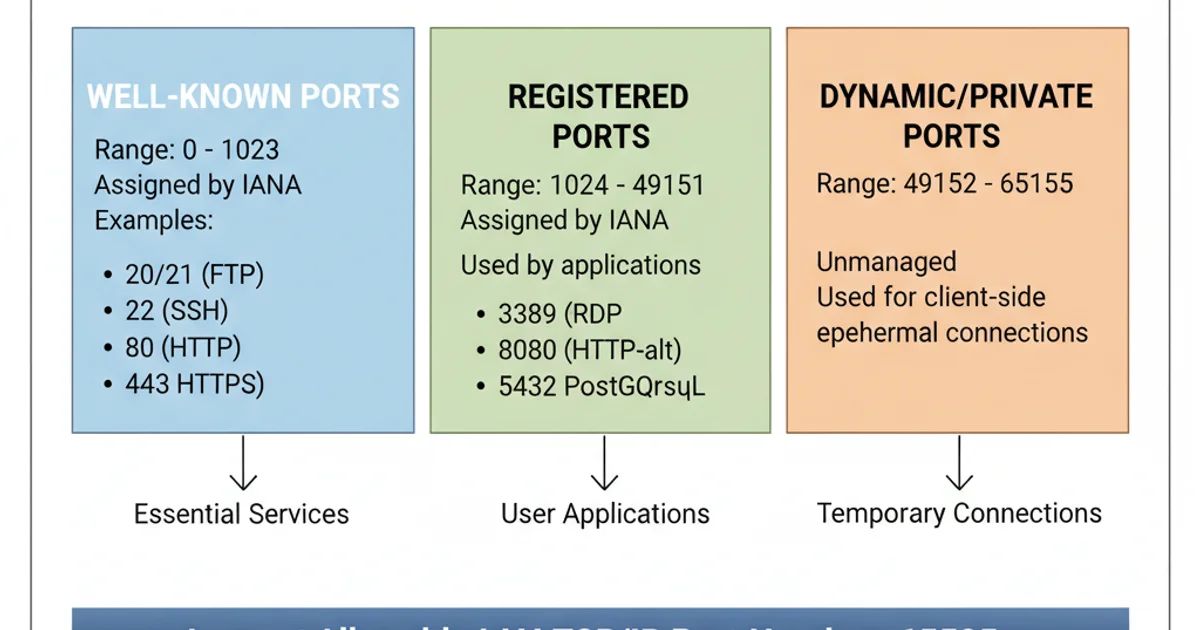What is the largest TCP/IP network port number allowable for IPv4?
Categories:
Understanding TCP/IP Port Numbers: The Largest Allowable for IPv4

Explore the range of TCP/IP port numbers, focusing on the maximum allowable value for IPv4, and delve into their classification and practical implications.
TCP/IP port numbers are fundamental to network communication, acting as endpoints for specific services and applications on a host. When a client wants to connect to a server, it directs its request to a specific IP address and port number. This article will clarify the maximum allowable TCP/IP port number for IPv4, explain the different categories of ports, and discuss their significance in network architecture.
The Maximum TCP/IP Port Number
The largest TCP/IP network port number allowable for IPv4 (and IPv6) is 65535. This number is derived from the fact that port numbers are represented by a 16-bit unsigned integer. A 16-bit unsigned integer can hold values from 0 to 2^16 - 1. Therefore, 2^16 - 1 equals 65536 - 1, which is 65535.
flowchart TD
A[Port Number Representation] --> B{16-bit Unsigned Integer}
B --> C[Minimum Value: 0]
B --> D[Maximum Value: 2^16 - 1]
D --> E[Calculation: 65536 - 1]
E --> F[Result: 65535]
F --> G["Largest Allowable Port Number (IPv4/IPv6)"]Derivation of the maximum TCP/IP port number.
While port 0 is technically reserved and not typically used for services, the range effectively starts from 1. This gives us a total of 65,535 usable ports for various network services and client connections.
Port Number Categories
Port numbers are broadly categorized by the Internet Assigned Numbers Authority (IANA) into three main ranges, each serving a distinct purpose:

The three main categories of TCP/IP port numbers.
1. Well-Known Ports (0-1023)
These ports are reserved for common, universally recognized services. They are typically used by system processes or by programs executed by privileged users. Examples include:
- 20, 21: FTP (File Transfer Protocol)
- 22: SSH (Secure Shell)
- 23: Telnet
- 25: SMTP (Simple Mail Transfer Protocol)
- 53: DNS (Domain Name System)
- 80: HTTP (Hypertext Transfer Protocol)
- 443: HTTPS (Hypertext Transfer Protocol Secure)
2. Registered Ports (1024-49151)
These ports are not assigned by IANA but can be registered by software corporations or developers for specific applications. While not as universally known as well-known ports, their registration helps prevent conflicts. Examples include:
- 1433: Microsoft SQL Server
- 3306: MySQL
- 8080: HTTP Alternate (often used for web proxies or development servers)
3. Dynamic/Private/Ephemeral Ports (49152-65535)
These ports are not registered with IANA and are typically used by client applications when initiating connections. When a client connects to a server, the operating system dynamically assigns an available port from this range for the client's end of the communication. These ports are temporary and are released once the connection is closed.
Practical Implications and Security Considerations
Understanding port numbers is crucial for network administration, security, and application development. Firewalls, for instance, heavily rely on port numbers to filter traffic, allowing or blocking connections based on predefined rules. Security professionals often scan for open ports to identify potential vulnerabilities, as an open port might indicate an active service that could be exploited.
For developers, choosing appropriate port numbers for custom applications is important. While using registered ports for well-known services is standard, custom applications often use ports within the registered range (e.g., 8080, 8443) or dynamic ports for client-side connections. Avoiding well-known ports for non-standard services helps prevent confusion and potential conflicts.
# Check open ports on a Linux system
sudo netstat -tulnp | grep LISTEN
# Check open ports on Windows (Command Prompt)
netstat -ano | findstr LISTENING
Commands to list listening TCP/UDP ports on Linux and Windows.